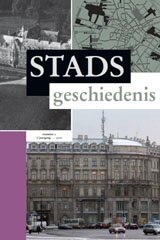Editie 2010 - 2

|
Elise Van Nederveen Meerkerk Ellen Burm en Bert De Munck Jens van de Maele (Review) Ed Taverne (Review) Jan Hein Furnée, Inge Bertels, Bruno Blondé, Hilde Greefs, Peter Stabel en Maarten van Dijck |
Abstracts
Elise van Nederveen Meerkerk - Giving after life. Charitable bequests and urban giving culture in Utrecht and Zwolle, 1600-1800.
Both contemporaries and historians have generally considered welfare in the early modern Dutch Republic (1581-1795) as relatively generous and effi cient. Like in most other preindustrial societies, however, Dutch poor relief was not centrally organized, nor publicly financed. Although it is supposed that Dutch citizens openhandedly donated private gifts to the needy, this has never been underpinned empirically. By looking at bequests by Dutch citizens, this article aims to shed light on broader questions about redistribution of income, and the relationship between the relative prosperity of the Dutch Republic and its urban provisions of social care. Several possible motives for individual citizens to give to charitable goals are being scrutinized. It is argued that the ‘proximity’ of givers and receivers on different levels was of crucial importance for the giving behaviour of citizens. This proximity was narrowly connected to the urban environment and the way local poor relief was organized. Of course, individual characteristics and circumstances of donors also played a role, but the closeness of the intended receivers – the ‘deserving poor’, usually meaning fellow citizens and even coreligionists – was often a decisive motive for benefactors, enabling them to fulfi l their religious and civic duties within their town of residence.
Ellen Burm and Bert De Munck - Marrying a baker in Brussels during the transition from the ancien régime to the nineteenth century
This article examines marital strategies of a typical urban middling group (bakers) at the end of the ancien régime and the beginning of the ‘modern’ era. It does so for Brussels, which at the time experienced a transformation from a corporative bulwark to the modern capital of the first ‘liberal’ nation on the continent. Unsurprisingly this resulted in tensions between the ‘old fashioned’ corporative world on the one hand, and a more modern world controlled by capital, finance and independent professions on the other hand. Our starting point is that bakers, firmly rooted in the corporative structures, had to adapt to the requirements of the more modern retail sector, which may have resulted in specifi c marital strategies within and between (baking) families. In order to analyze this, we call on two sets of theories, one stressing marriage strategies in seeking the continuity of assets and property, the other stressing marital strategies geared towards the building of larger networks (among bakers and similar professions). We conclude that both theories apply partially, but an important new element is that the so called ‘traditional groups’, in a sense, were used as a lever for the integration of the ‘new and modern’ groups in the transition from the eighteenth to the nineteenth century.
Jens van de Maele - Urban greenspace policy in the Belgian village of Leuven during the interbellum period
The first public urban greenspaces (parks, squares, etc.) were not constructed for the lower social classes. To a certain degree, they were ‘exclusive’ places, mainly destined for use by the upper class. In the international literature, it is pointed out that around 1900, city administrations began to take more notice of its working-class inhabitants and their interests, which led to urban greenspaces becoming more ‘inclusive’: special areas for workers’ children were created (like playgrounds and sports fi elds), working-class neighbourhoods were provided with greenspace, etc. This article analyses urban greenspace policy in the provincial town of Leuven (Flemish Brabant), and shows that the shift from the ‘exclusive’ to the ‘inclusive’ paradigm was not nessecarily absolute. ‘Exclusivist’ views on urban greenspace could persist after the First World War; moreover, the implementation of the ‘inclusive’ paradigm could lead to political dissension.